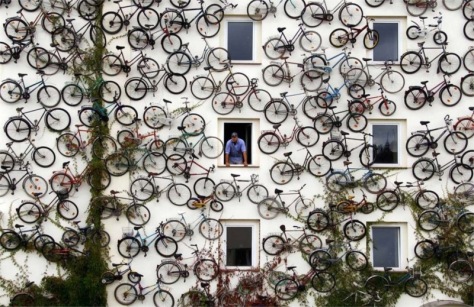The streets in the city of Leiden, can be quite beautiful, yet one can’t help but notice that most streets you walk down are barren of any natural greenery. A city that naturally has plenty of rainwater to sustain plant life without the use of artificial watering devices, somehow is devoid of lush greenery. How can this be? The all-encompassing tiling that has been laid out all throughout the city has prevented any plant life from forming naturally. Sure, there may be trees here and there, encircled by bricks, yet thriving gardens, and green walkways are far from being seen.
Let’s take a look at one of Leiden’s most ‘green’ streets : “de groenesteeg” (pictured above): even a street that is named the green street, and is well known for being filled with plant-life, fails to have even one full yard of open earth surface. There may be many pots and other plant carriers, placed on top of the tiled surface: but where is the connection to the earth underneath? In Leiden’s Agenda for 2030 sustainability goals, the municipality clearly states that they’d like to push citizen participation in improving biodiversity within the city. In the past year, they have already introduced subsidies to reimburse and financially support residents with un-tiling their front gardens, replacing the tiles with a green, flora filled garden. Measures have already been taken to encourage resident participation in improving biodiversity in the city. But, how effective have these measures been thus far? I decided to get hands-on and investigate how the residents themselves experience the municipalities attempts at increasing biodiversity, by going through the streets of Leiden city, and knocking on residents’ doorbells. The conversations I had with the locals themselves, opened my eyes to quite a number of things regarding this subject. Not only concerning the resident’s awareness of the cities agenda, but also how the residents themselves feel about biodiversity loss, green spaces, and un-tiling their front gardens.
Let’s begin with the most discouraging insight: none of the residents that I interviewed knew that getting rid of the first 20 cm of tiles in front of their house was legal to do, let alone that there are subsidies available for un-tiling their front gardens.

One woman around 60, living in the Uiterstegracht, stated that she had asked the government about 10 years ago, if she could un-tile the front of her house, to which they refused due to fear of the roots of plants destabilizing the tiles surrounding it. The municipality clearly had a different agenda 10 years ago, and yet nothing seems to have been done to inform citizens of their new views on what is encouraged, allowed, and no longer condemned. This woman clearly wished to un-tile her front garden, but has never done so due to thinking it was an illegal act. When I informed her of the subsidies now available to encourage the re-greening of tiled areas, she was astonished. “Now I will definitely get the front of my house un-tiled”, she exclaimed, explaining that it not only is more convenient than having pots in front of her house, but also helps with water retention, preventing run-off. This woman was clearly knowledgeable about sustainability topics, and yet she was completely unaware of any of the municipalities endeavors regarding sustainability. And I dare say: that is truly a shame.
Indeed, not one of the residents I interviewed were aware of Leiden’s Sustainability Agenda. The good news is that once I informed them of Leiden’s agenda, all voiced their approval of Leiden’s plan to become more sustainable. So indeed, it seems that residents tend to be pro-sustainable actions when it comes to biodiversity and re-greening the city. The problem is, a lack of knowledge, and surprisingly, I have found, a lack of space for parking bikes. The two residents I interviewed who were pro-biodiversity yet would not un-tile the front of their houses even with help from a subsidy, said that it would deter them from being able to park their bikes in front of their house. Thus I think Leiden has overlooked two important aspects in their plan to encourage citizen involvement regarding biodiversity: the need for the citizens’ awareness, and solutions regarding bike parking. 



Brilliant! Love your engagement! I wonder how such a crucial mistake could happen to the municipality and board of sustainability planers. Did you manage to speak to many people? And did they have an extended interest in supporting wildelife in general or mainly focused on greenery?
LikeLike
It seems like the municipality of Leiden really has some work to do when it comes to raising the citizens’ awareness. From your blogpost, the door-to-door method actually appears to be the most effective! Maybe posters and media only can get you to a certain point, and what the municipality really should do in order to change things, is to TALK to people. That kind of measure is possible in a city the size of Leiden. As for the bikes, I don’t see the problem with parking them on the mawn. Maybe it’ll get a little muddy when it’s raining, but it’ll dry up again.
LikeLiked by 1 person
I think limiting the removal of tiles to 20 cm from the house is very important here, to keep the streets looking clean. It doesn’t have to be big, streets with long rows of plants like small flowers could quite possibly have a very good impact on for example insect biodiversity!
LikeLiked by 1 person
Wow this is really surprising. The goals of Leiden seems so progressive with their plans. But unfortunately not everyone is informed. It is really interesting. But I am really wondering how the municipality have to change this? How do they need to inform people? In February there is an information event in the evening. But is this enough? What do you guys think?
And the thing with the bike problem. If I’m honest I agree with noraslater. What does bike parking has to do with biodiversity?
LikeLike
First of all, great of you Sophie that you went to the people! In this way, you can really get an insight in the existing problems.
I do agree with Nora that the municipality has a lot of work to do; they should try to raise the awareness. Maybe with just an old-fashioned door-to-door method, or with leaving brochures at their houses? Not everyone has a social media account, especially the older people not (and I do think that they are the ones most interested in having a front garden). As for the bike problem, I think it is a serious problem that needs to be tackled; especially while Leiden is known to be a ‘bikecity’. So maybe we should come up with more parking lots for bikes, so we can indirectly increase the biodiversity?
LikeLiked by 1 person
Hey Sophie!
First of all, great blog haha! I like the question you pose at the beginning, because it does seem quite odd that a city that has so much natural rainfall does have so little vegetation. Also, by writing your blog I do think you actually made a change, as this woman you talk about now actually might consider un-tiling her front garden, which would be great! Besides re-greening front gardens, vertical gardening could really work as well. I am in the climate adaptation group, and vertical gardening does add to the greenness of Leiden, but also provides cooling during periods of extreme heat and imrpoves air quality. Your blog is critical, makes its readers think and got me excited about the topic, so I think you succeeded in that sense! Well done!
LikeLiked by 1 person